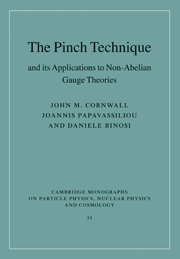Book contents
- Frontmatter
- Contents
- Introduction: Why the pinch technique?
- 1 The pinch technique at one loop
- 2 Advanced pinch technique: Still one loop
- 3 Pinch technique to all orders
- 4 The pinch technique in the Batalin–Vilkovisky framework
- 5 The gauge technique
- 6 Schwinger–Dyson equations in the pinch technique framework
- 7 Nonperturbative gluon mass and quantum solitons
- 8 Nexuses, sphalerons, and fractional topological charge
- 9 A brief summary of d = 3 NAGTs
- 10 The pinch technique for electroweak theory
- 11 Other applications of the pinch technique
- Appendix: Feynman rules
- Index
9 - A brief summary of d = 3 NAGTs
Published online by Cambridge University Press: 04 February 2011
- Frontmatter
- Contents
- Introduction: Why the pinch technique?
- 1 The pinch technique at one loop
- 2 Advanced pinch technique: Still one loop
- 3 Pinch technique to all orders
- 4 The pinch technique in the Batalin–Vilkovisky framework
- 5 The gauge technique
- 6 Schwinger–Dyson equations in the pinch technique framework
- 7 Nonperturbative gluon mass and quantum solitons
- 8 Nexuses, sphalerons, and fractional topological charge
- 9 A brief summary of d = 3 NAGTs
- 10 The pinch technique for electroweak theory
- 11 Other applications of the pinch technique
- Appendix: Feynman rules
- Index
Summary
Introduction
NAGTs in three dimensions have valuable applications in their own right because they are the high-temperature limit of d = 4 NAGTs with infrared slavery (see Chapter 11 for more details). They also lead to important insights into d = 4 NAGTs at zero T, and in many ways, d = 3 QCD is more interesting to study to gain this insight than the far more often-invoked two-dimensional theories. It is not a free-field theory (as is a d = 2 pure-gauge NAGT), and it has many features strongly analogous to those of d = 4 NAGTs that are best understood by applying the pinch technique. In particular, although a d = 3 NAGT cannot be asymptotically free (because it is superrenormalizable, not possessing the usual renormalization group), it is still very much infrared unstable, with even worse singularities than those in d = 4. Although this d = 3 infrared slavery had been strongly suspected before the pinch technique on the basis of conventional Feynman graph calculations, it took the pinch techniqe to settle the issue and demonstrate the existence of infrared slavery in d = 3 NAGTs.
Because a d = 3 NAGT is the critical nonperturbative part of the high-temperature behavior of its d = 4 counterpart, infrared slavery prevents the use of perturbation theory (beyond) in understanding all the phenomena of high temperature, including generation of a so-called magnetic mass, which vanishes identically to all orders of perturbation theory.
- Type
- Chapter
- Information
- Publisher: Cambridge University PressPrint publication year: 2010

